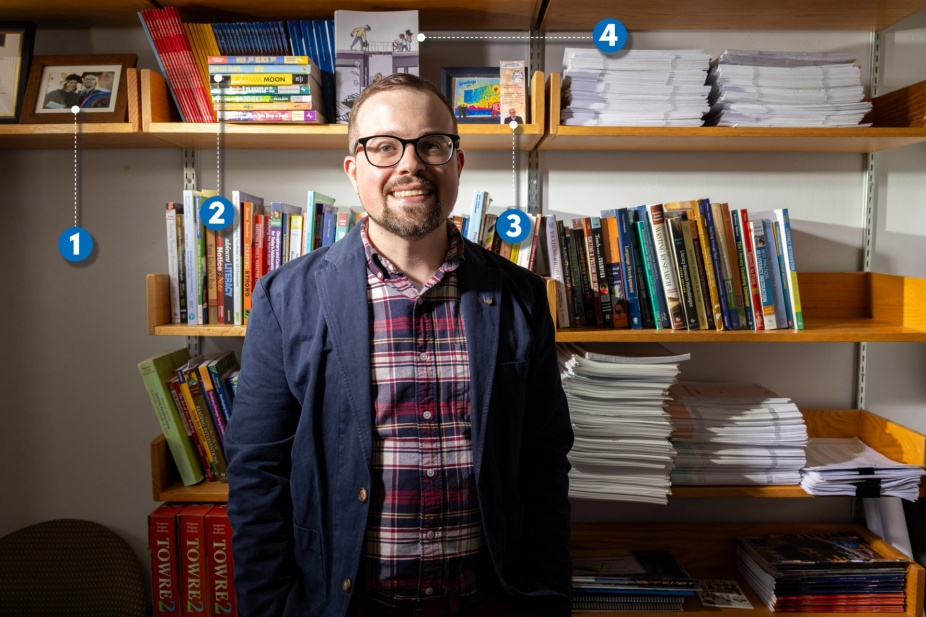Shining the light on young readers and writers
John Z. Strong develops innovative classroom intervention to help students and teachers
BY ANN WHITCHER GENTZKE
Newly embarked on his teaching career, John Strong witnessed what it’s like for students to try to catch up with reading, when the underpinnings of literacy are missing.
While teaching English in a Delaware high school, Strong was startled to find 17-year-olds in his classroom who had never passed ninth-grade English and so were stuck in the ninth-grade. “That was my first job teaching high school,” said Strong, assistant professor of literacy education in GSE. “I had been hired only the day before, so I wasn’t prepared to teach children with that level of reading difficulties in high school. I thought, ‘How can I learn how to serve these students?’’
In response, Strong returned to the University of Delaware, where he earned a master’s degree in reading. “This is where I really learned about reading science, evidence-based instruction, and experimental methods for developing interventions.” Faculty there, too, emphasized the close relationship between reading and writing, the integration of which is insufficiently studied, compared to investigations of reading and writing viewed separately.
Much of this training overlapped with Strong’s doctoral studies, also at the University of Delaware, where he researched and devised tools and interventions that teachers and students can use in the classroom. His study of a text structure intervention for reading and writing in grades 4 and 5 won the 2020 Timothy and Cynthia Shanahan Outstanding Dissertation Award from the International Literacy Association.
Further research led to an evolution of these instructional routines. Strong is now principal investigator on a grant from the Advanced Education Research and Development Fund to study his intervention called Read STOP Write. (STOP stands for “Summarize, Text structure, Organize, Plan.”) Students use informational texts aligned with science and social studies topics they’re learning about during other parts of the school day. They first read to determine the meaning of new words and identify the main idea and key details. “We teach them strategies for breaking apart multisyllabic words and then for learning vocabulary—focusing on prefixes and suffixes and using context clues to infer the meaning of the word,” Strong explained. After reading, they summarize the main idea and key details, identify the text structure, organize information using a text structure map, and plan their writing using a graphic organizer. They then write an informative paragraph of what they’ve just read.
- Access and Equity
- Achievement
- Assessment
- Elementary Education
- English Education
- Curriculum and Instruction
- Equity and Poverty
- Design Experiments
- Literacy
- Reading Instruction
- Writing Instruction
- Quantitative Research Methods
- Research Design
- Research Methods
This past spring, Read STOP Write was implemented locally in seven fourth-grade classrooms and five fifth-grade classrooms. “Currently, we have schools within four districts implementing it in New York, and two districts in Michigan are implementing it as well,” Strong said.
“I wanted to develop programs that are easy and intuitive and feasible for teachers and students to use in real classroom settings,” Strong added. “It’s different than the way that text structure, and reading and writing, are typically taught in schools. I think it’s really an attractive option for teachers.”

Photo of Strong in 2019 with Sharon Walpole, his doctoral adviser and professor of education at the University of Delaware, on the occasion of receiving his PhD. “During my master’s program, I met Sharon, who became my PhD adviser. She taught me everything I knew at that time about how to teach beginning readers [and] children with reading difficulties.”

“These third- through fifth-grade books were part of our summer school program to build fluency and comprehension. Believe it or not, kids don’t read a lot of trade books in school—they read a lot of textbooks. Fourth- and fifth-graders saying it’s their first chapter book has been a highlight of my career.”

Cover of book by Dutch researcher Suzanne Bogaerds-Hazenberg. Strong was honored that his work was acknowledged by the author, who has also studied the impact of text structure on children’s reading skills. “My work was influential for her on her own dissertation."

“Garfield” bookmark features Mike McKenna, who was Thomas G. Jewell Professor of Reading in the School of Education and Human Development at the University of Virginia until his death in 2016. “Mike worked with ['Garfield' creator] Jim Davis to create a survey for students about their reading motivation.”
